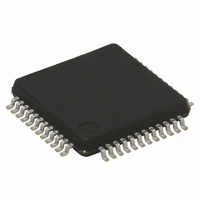STM32F100C6T6BTR STMicroelectronics, STM32F100C6T6BTR Datasheet - Page 20

STM32F100C6T6BTR
Manufacturer Part Number
STM32F100C6T6BTR
Description
IC ARM CORTEX MCU 32KB 48LQFP
Manufacturer
STMicroelectronics
Series
STM32r
Datasheet
1.STM32F100R4T6B.pdf
(87 pages)
Specifications of STM32F100C6T6BTR
Core Processor
ARM® Cortex-M3™
Core Size
32-Bit
Speed
24MHz
Connectivity
I²C, IrDA, LIN, SPI, UART/USART
Peripherals
DMA, PDR, POR, PVD, PWM, Temp Sensor, WDT
Number Of I /o
37
Program Memory Size
32KB (32K x 8)
Program Memory Type
FLASH
Ram Size
4K x 8
Voltage - Supply (vcc/vdd)
2 V ~ 3.6 V
Data Converters
A/D 10x12b; D/A 2x12b
Oscillator Type
Internal
Operating Temperature
-40°C ~ 85°C
Package / Case
48-LFQFP
Core
ARM Cortex M3
For Use With
STM32100B-EVAL - EVAL BOARD FOR STM32F100VBT6
Lead Free Status / RoHS Status
Lead free / RoHS Compliant
Eeprom Size
-
Lead Free Status / Rohs Status
Details
Available stocks
Company
Part Number
Manufacturer
Quantity
Price
Company:
Part Number:
STM32F100C6T6BTR
Manufacturer:
STMicroelectronics
Quantity:
10 000
Part Number:
STM32F100C6T6BTR
Manufacturer:
ST
Quantity:
20 000
Description
2.2.18
2.2.19
2.2.20
2.2.21
2.2.22
20/87
Serial peripheral interface (SPI)
Up to two SPIs are able to communicate up to 12 Mbit/s in slave and master modes in full-
duplex and simplex communication modes. The 3-bit prescaler gives 8 master mode
frequencies and the frame is configurable to 8 bits or 16 bits.
Both SPIs can be served by the DMA controller.
HDMI (high-definition multimedia interface) consumer
electronics control (CEC)
The STM32F100xx value line embeds a HDMI-CEC controller that provides hardware
support of consumer electronics control (CEC) (Appendix supplement 1 to the HDMI
standard).
This protocol provides high-level control functions between all audiovisual products in an
environment. It is specified to operate at low speeds with minimum processing and memory
overhead.
GPIOs (general-purpose inputs/outputs)
Each of the GPIO pins can be configured by software as output (push-pull or open-drain), as
input (with or without pull-up or pull-down) or as peripheral alternate function. Most of the
GPIO pins are shared with digital or analog alternate functions. All GPIOs are high current-
capable except for analog inputs.
The I/Os alternate function configuration can be locked if needed following a specific
sequence in order to avoid spurious writing to the I/Os registers.
Remap capability
This feature allows the use of a maximum number of peripherals in a given application.
Indeed, alternate functions are available not only on the default pins but also on other
specific pins onto which they are remappable. This has the advantage of making board
design and port usage much more flexible.
For details refer to
alternate functions and the pins onto which they can be remapped. See the STM32F10xxx
reference manual for software considerations.
ADC (analog-to-digital converter)
The 12-bit analog to digital converter has up to 16 external channels and performs
conversions in single-shot or scan modes. In scan mode, automatic conversion is performed
on a selected group of analog inputs.
The ADC can be served by the DMA controller.
An analog watchdog feature allows very precise monitoring of the converted voltage of one,
some or all selected channels. An interrupt is generated when the converted voltage is
outside the programmed thresholds.
Table 4: STM32F100xx pin
STM32F100x4, STM32F100x6, STM32F100x8, STM32F100xB
Doc ID 16455 Rev 6
definitions; it shows the list of remappable













